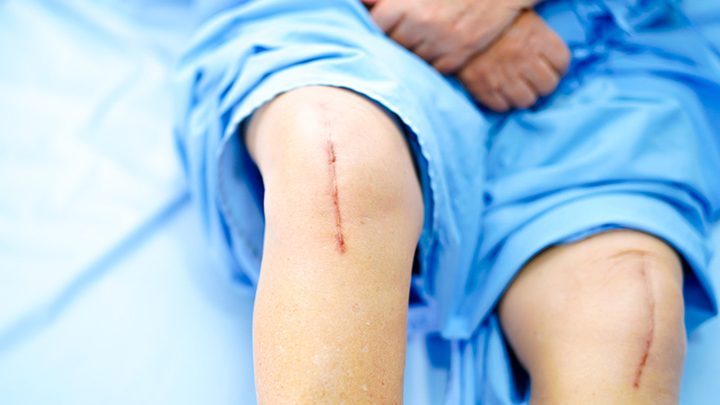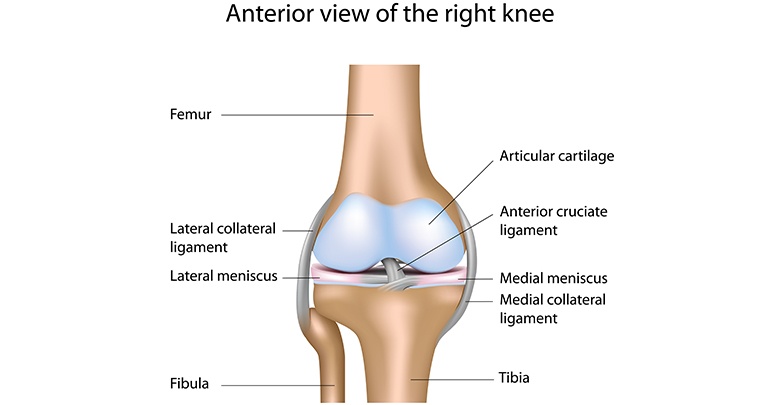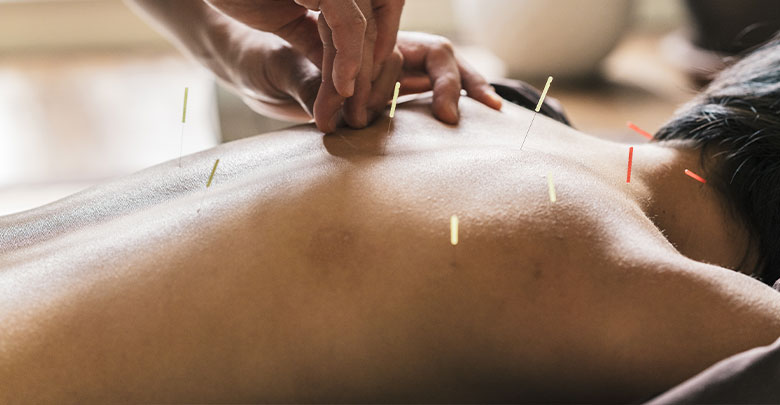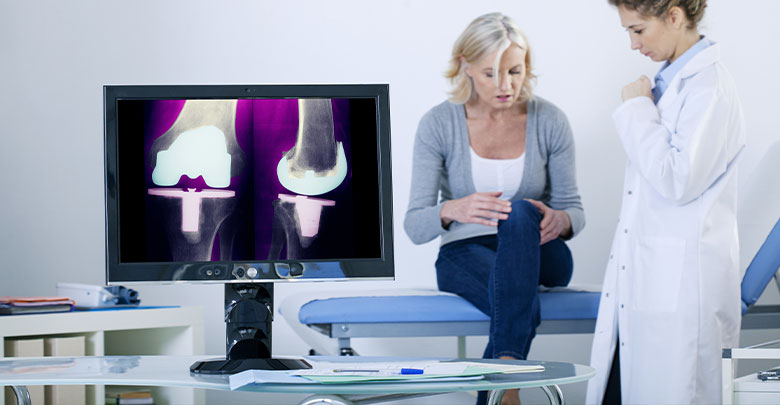Surgery for Knee Replacement – your questions answered
Do you want to find out more about surgery for knee replacement?

Do you want to find out more about surgery for knee replacement? You are not alone. Knee osteoarthritis affects millions of people worldwide. Statistics show that every third adult over the age of 45 suffers from osteoarthritis
USE the OMH exclusive code "HEALTH15" to Save 15%Anatomy of the knee joint
The knee is the largest joint in the human body and is situated where the thigh bone (femur) meets the shin bone (tibia) of the lower leg. It supports the weight of the entire body above, so it has to sustain a lot of load and stress. This means that the rounded ends, called condyles, of the femur (thigh bone) are exposed to the most loading. In a healthy knee, these two condyles of the femur are covered with a layer of tissue called articular cartilage. Articular cartilage allows the bones to glide and move forwards and backwards smoothly and easily. The kneecap, or patella, rests between the condyles at the lower end of the femur and prevents the knee from bending the wrong way.

What is osteoarthritis?
Knee osteoarthritis affects millions of people worldwide. Statistics show that every third adult over the age of 45 suffers from osteoarthritis. Knee osteoarthritis damages the layer of cartilage tissue between the femur and tibia. The cartilage gradually gets thinner and thinner over time. This can be due to prior extreme sports (some examples would be activities like marathon running, rugby, or football). Othertimes, the cartillage becomes damaged due to a prior injury to the other anatomical structures of the knee – such as the ligaments, the menisci, or the cartilage itself can be damaged from an injury. In other cases osteoarthritis develops as a result of being knocked kneed (X) or bow-legged (O) or from being overweight. When it has progressed far enough, the cartilage may wear away so much that the bones rubbing against each other start causing permanent damage to the underlying (subchondral) bone.
Why do doctors do surgery for knee replacement?
During a knee replacement operation, the damaged ends of the bones, and any remaining hardened unhealthy cartilage are removed and replaced with surgical metal and high- tech plastic. The plastic replaces the cartilage, thereby enabling your joint to move as freely and normally as is possible. The interlocking parts of the artificial joint allow your knee to bend correctly and prevent it from bending too far back.
Do I need a knee replacement?
There is no exact list of factors for determining whether you should have a knee replacement. However if your knee causes you debilitating pain when you take part in everyday activities, or if you experience instability or loss of function, then you may be a candidate for knee replacement surgery.
What can I try before surgery for knee replacement?
A healthcare professional will try other methods before suggesting knee replacement surgery. These might include medication, physical therapy, acupuncture and weight loss.

If your symptoms are still debilitating, an orthopaedic surgeon will need to assess you thoroughly and propose new recommendations for possible surgical options.
Is there a good age to undergo surgery for knee replacement?
The majority of people who have knee replacement surgery are over the age of 60. Most orthopaedic surgeons would advise you, that a knee replacement will last for an average of 15 years. Bear in mind that the earlier you have the knee replacement surgery, the more likely the chance that you will require further surgery later on. It is important to note that this age will vary greatly from person to person, and also that the length of time a replacement lasts also varies from person to person.

Advantages of knee replacement surgery
If you have been suffering from debilitating knee pain and you have the diagnosis of advanced osteoarthritis, the advantages of having knee replacement surgery will be hard to argue. The advantages include:
- Freedom from, or at least a dramatic reduction in pain
- Improved mobility and knee function
- Improved ability to take part in everyday activities and exercise.
Disadvantages of knee replacement surgery
As with any other surgical procedure, there can be possible downsides to knee replacement surgery. These may include:
- You will have an artificial joint instead of a ‘normal’ knee.
- Not every patient becomes completely 100% pain free following knee replacement surgery
- Although kneeling on the replacement joint is perfectly safe, some patients find it challenging and uncomfortable to put weight on the scar where surgery took place.
- The replacement joint may make a slight click or even a clunk noise when in motion.
- During recovery, you may experience some numbness around the scar while the nerves are healing. This will usually only improve about two years after surgery.
- Younger patients will, most likely, require follow up knee surgery later in their life, as a knee replacement lasts for an average of 15 years.
Is there a way to avoid surgery for knee replacement?
Before deciding on and scheduling knee replacement surgery, most doctors recommend alternative treatments first. These include:
- Lifestyle changes: losing weight will put less mechanical stress on your knee.
- Exercise: activities like cycling, swimming, elliptical trainer, Pilates or yoga will not put more strain on your knee, and can greatly assist in strengthening your knee.
- Medication: Doctors will most likely prescribe non-steroidal anti-inflammatory medication, as well as pain killers.
Although these methods can be very effective, if your arthritis is too advanced, knee replacement surgery may be your only remaining option.
What would prevent me from having knee replacement surgery?
There are extreme situations that may prevent you from qualifying for knee replacement surgery. Regardless of how severe your arthritis may be, most medical professionals will refuse to perform surgery on you if:
- You have exceptionally weak quadriceps (thigh muscles) If your quadriceps are extremely weak that would mean that they would not be able to support your new replaced knee joint. To find out how to strengthen your quadriceps, check out this video
- If you are overweight and have a BMI (Body Mass Index) over 30 Generally speaking your joint health is much improved when you are at your optimal weight and have a BMI of around 20-25. A healthy diet assists you in achieving your optimal weight. For more on weightless, check out this article.
What do I need to do to prepare for surgery for knee replacement?
Being in good general health is imperative before your operation. If you have chronic conditions like diabetes or high blood pressure, or are on any medications, you must disclose all this information to your surgeon before scheduling the surgery. This ensures that these conditions can be well taken care of by the anaesthetist and your doctor.
It is also very important to minimise any risk of infections before or after the surgery. Things like washing hands, being in a clean environment, looking after the wound and dressings as explained by the nurses, not bathing (immersing the wound in water) until being given the all clear by your doctor, and avoiding sick people before and after surgery are important ways to avoid infection pre and post surgery.
As elaborated above, it important to strengthen your quadriceps prior to surgery, as this will greatly improve your recovery time. For ideas on exercises, check out the exercise videos in the training section of OhMy.Health.
Before the surgery
A few weeks before your scheduled operation you will be examined to ensure that you are fit for surgery. The following may be some of the tests you can expect:
- blood tests for anaemia and to ensure that your kidneys are in good working order
- an MRSA swab to pick up whether you might be carrying resistant bacteria
- a urine sample to ensure that you are free from infection
- an ECG (electrocardiograph) to ensure that your heart is strong and healthy.
During this visit, you can get clarification on any concerns you might have. Schedule a meeting with your physiotherapist to discuss any exercises that you will need to do after the operation.
How do they do the surgery for knee replacement?
The surgeon will make an incision over your knee to access the damaged area of your joint. During knee replacement surgery, both sides of your knee joint are removed and are replaced with metal and hi-tech medical-grade plastic. The metal and plastic components are shaped in such a way to ensure natural movement of your knee. The surface of the components (parts) is textured or coated where it comes into contact with the natural bone, in order for it to form a natural and optimal bond as it heals.
Surgery lasts for anything from 1 to 3 hours. This is a very common procedure that most orthopaedic surgeons will have extensive experience in performing.
What can I expect after the knee replacement surgery?
When you wake up from surgery, you will have a bandage over your knee and a drain (which consists of a thin plastic tube inserted into the joint – similar to an IV drip – and a small bag of sorts) to get rid of excess fluid from the joint. Your knee will be elevated. Your doctor will administer medication to help you manage pain, as well has antibiotics to reduce the risk of infection. You may also be on blood thinning medications if you are at risk for blood clots. Sometimes they put special booties around your feet which help to maintain healthy circulation as thie plays an important role in preventing blood clots.

You will be scheduled for physical therapy to get you moving as soon as possible, as this speeds up the healing process. You may initially walk with crutches or a walking frame – this depends on the exact type of surgery perfomred as well as your level of strength, balance and how you feel.
When you return home, physical therapy will continue regularly for a few weeks to months, and you will need to perform specific exercises at home designed to improve your knee range of movement, improve your muscle strength and ease the adjustment and healing of your new knee. The exercises would be similar to the 8 Best Knee Rehabilitation Exercises which you can watch.
Looking after your knee replacement
The total healing time following knee replacement surgery can be as long as two years after your surgery. This depends greatly on your usual healing speed, and on whether you stick to doing your prescribed exercises.
During that time you might expect the following:
Stiffness – this is quite normal during the healing period. This should improve as you get more into your exercises. For more information, check out this article.
If you still experience no relief from the stiffness after about five weeks following surgery, please contact your surgeon.
Pain – experiencing pain for the first two months after surgery is quite normal, and you will most likely need pain medication for that period. If you still experience pain after six months post-surgery, please contact your surgeon.
Swelling –it is very typical to experience swelling after any surgery. You might notice swelling around your ankle and foot. This should dissipate after about three months following the surgery. As you exercise more and more, the swelling should improve. For tips on dealing with the swelling, check out this article.
If the swelling in your ankle or calf worsens, and/or you also experience symptoms such as shortness of breath or coughing, be sure to contact your doctor immediately as it may be the development of a blood clot which can be extremely serious.
Infection – if you notice any signs of infection, you must contact your doctor immediately. Possible signs of infection may include:
- inability to walk without pain after the point at which the doctor said walking should be pain-free
- increasing pain and stiffness in the artificial joint
- warmth, redness, and tenderness around the incision or the whole knee
- grey liquid draining from the incision, especially if it smells bad
- a fever above 100°F (37.8°C)
- chills or night sweats
- fatigue
Summing up
Surgery for knee replacement is a big operation, and it is a big decision to take to undergo such a surgery. However it can also potentially give you a new lease on life, and enable you to enjoy your daily life so much more. It may also give you the opportunity to improve your physical fitness and explore new activities!
It is very important to follow the doctors and physical therapists advice, and to do your rehabilitation exercises regularly in order to get optimal results following surgery… remember that the new knee joint is only half of the solution. The other half depends on you to improve the muscle strength and range of movement …
OhMy.health has designed a physiotherapy exercise video which shows you how to strengthen your knee pre- and post op.
References
1. Neogi T et al. 2013 https://academic.oup.com/rheumatology/article/44/8/1032/1772033
2. Michael JPW et al. 2010 https://www.ncbi.nlm.nih.gov/pmc/articles/PMC2841860/
3. Vincent KR et al. 2012 https://www.ncbi.nlm.nih.gov/pmc/articles/PMC3635670/
4.Heijink A et al. 2011 https://link.springer.com/article/10.1007/s00167-011-1818-0
5.Harris WH et al. https://www.nejm.org/doi/full/10.1056/NEJM199009133231106
6.McClelland JA et al. 2007 https://www.sciencedirect.com/science/article/abs/pii/S096801600700049X
7. Evans JT et al. 2019 https://www.thelancet.com/journals/lancet/article/PIIS0140-6736(18)32531-5/fulltext
8. Blom AW et al 2016 https://www.ncbi.nlm.nih.gov/books/NBK379640/
9. Amanatullah DF et al. https://www.researchgate.net/publication/276100954_Perioperative_management_in_total_knee_arthroplasty_Patient_selection_pain_management_thromboprophylaxis_and_rehabilitation